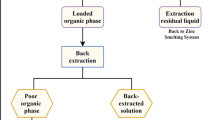Abstract
To realize the optimal control of the zinc leaching process, an accurate mathematical model is necessary. However, the modeling of zinc leaching process faces the challenges of complex reaction rate, low data quality and error transmission of cascade modeling. To solve these problems, a hybrid model of mass-concentration conservation and neural network (MCCNN) is proposed. First, the method of integral regularization is introduced to process data and reduce the influence of measurement noise. Then, a model based on mass-concentration conservation mechanism model and data-driven model is proposed to build sub-models of each unit, which can solve the problems of insufficient data and complex reaction rate. Finally, a parallel error compensation structure is proposed to alleviate the error transfer caused by the cascade of sub-models. This hybrid framework provides a feasible and effective solution for zinc leaching process modeling, and its effect is verified by numerical simulation and zinc leaching process case.





Similar content being viewed by others
References
T. Nan, J. Yang, W. Zeng, C. Tang, and Q. Hu, JOM 73, 1661 (2021).
B. Zhang, C. Yang, and W. Gui, IFAC-PapersOnLine 49, 161 (2016).
S. Fugleberg, A. Jarvinen, and E. Yllo, World Zinc 93, 241 (1993).
F. Tesfaye, A.E. Anderson, and M. Zhang, JOM 72, 2739 (2020).
A.E. Anderson, F. Tesfaye, C.O. Iloeje, and S. Nicol, JOM 74, 1485 (2022).
T. Lysak, N. Peskov, M. Slinko, Y.P. Tyulenin, V.Y. Bychkov, and V. Korchak, Chem. Eng. Sci. 144, 7 (2016).
S.M.S. Ghasemi, and A. Azizi, J. Market. Res. 7, 118 (2018).
B. Zhang, C. Yang, H. Zhu, Y. Li, and W. Gui, Chem. Eng. J. 284, 294 (2016).
Y.-F. Xie, S.-W. Xie, Y.-G. Li, C.-H. Yang, and W.-H. Gui, Control. Eng. Pract. 58, 54 (2017).
S. Wang, Q. Wang, M. Tian, X. Guo, Q. Tian, Z. Wang and S. Qu, JOM, 1 (2022)
D. Jiang, Z. Wang, J. Zhang, D. Jiang, K. Li, and F. Liu, JOM 74, 1633 (2022).
S. Malinov, and W. Sha, Jom 57, 54 (2005).
X. Yuan, Z. Ge, B. Huang, Z. Song, and Y. Wang, IEEE Trans. Industr. Inf. 13, 532 (2016).
K. Feng, J. Lu, and J. Chen, Chin. J. Chem. Eng. 23, 2048 (2015).
T. Turanyi, T. Berces, and S. Vajda, Int. J. Chem. Kinet. 21, 83 (1989).
Z. Zhang, and M.L. Free, JOM 71, 1623 (2019).
B. Sun, W.H. Gui, T. Wu, Y. Wang, and C.H. Yang, Hydrometallurgy 140, 102 (2013).
G. Hu, Z. Mao, D. He, and F. Yang, Comput. Chem. Eng. 35, 2611 (2011).
J. Zhang, Z.Z. Mao, R.D. Jia, and D.K. He, The Canadian Journal of Chemical Engineering 93, 1624(2015).
S. Zhang, F. Wang, D. He, and R. Jia, Powder Technol. 224, 253 (2012).
H. Zhu, J. Du, C. Zhou, and Y. Li, JOM 74, 1237 (2022).
B. Sun, W. Gui, Y. Wang, C. Yang, and M. He, Control. Eng. Pract. 44, 89 (2015).
Y.G. Li, W.H. Gui, K.L. Teo, H.Q. Zhu, and Q.Q. Chai, J. Process Control 22, 1878 (2012).
B. Zhang, C. Yang, H. Zhu, Y. Li, and W. Gui, Ind. Eng. Chem. Res. 52, 17074 (2013).
R. Jia, and F. You, AIChE J. 67, e17043 (2021).
Y. Xie, S. Xie, X. Chen, W. Gui, C. Yang, and L. Caccetta, Hydrometallurgy 151, 62 (2015).
Y.L. Yeow, S.R. Wickramasinghe, B. Han, and Y.-K. Leong, Chem. Eng. Sci. 58, 3601 (2003).
D. Olivet, J. Valls, M.A. Gordillo, A. Freixo, and A. Sanchez, J. Chem. Technol. Biotechnol. Int. Res. Process Environ. Clean Technol. 80(4), 425 (2005).
F. Parrino, G.C. Roda, V. Loddo, and L. Palmisano, J. Catal. 366, 167 (2018).
P.J. Davis and P. Rabinowitz, Methods of numerical integration, Courier Corporation, (2007).
J. Zhang, Y. Tan, S. Li, Y. Wang, and R. Jia, ACS Omega 4, 19880 (2019).
D.C. Psichogios, and L.H. Ungar, AIChE J. 38, 1499 (1992).
D.S. Lee, P.A. Vanrolleghem, and J.M. Park, J. Biotechnol. 115, 317 (2005).
Y. Cao, and D. Biss, J. Process Control 6, 37 (1996).
D. Han, X. Yang, R. Li, and Y. Wu, J. Clean. Prod. 231, 254 (2019).
S. Lu, J. Ding, and L. Liu, J. Chem. Eng. 66, 244 (2015).
S. Usmani, A.G. Quiroga, R.V. Padilla, G. Palmer, and M. Lake, Energy 211, 118658 (2020).
P. Ziółkowski, P. Madejski, M. Amiri, T. Kuś, K. Stasiak, N. Subramanian, H. Pawlak-Kruczek, J. Badur, Ł Niedźwiecki, and D. Mikielewicz, Energies 14, 6304 (2021).
M.-Z. Li, J.-M. Zhou, C.-R. Tong, W.-H. Zhang, and H.-S. Li, Metall. Res. Technol. 115, 107 (2018).
Acknowledgements
The authors acknowledge National Natural Science Foundation of China (Grant No. 92167105) and the graduate students of Central South University for the independent exploration and innovation project (2022ZZTS0684).
Author information
Authors and Affiliations
Corresponding author
Ethics declarations
Conflict of interest
On behalf of all authors, the corresponding author states that there is no conflict of interest.
Additional information
Publisher's Note
Springer Nature remains neutral with regard to jurisdictional claims in published maps and institutional affiliations.
Rights and permissions
Springer Nature or its licensor (e.g. a society or other partner) holds exclusive rights to this article under a publishing agreement with the author(s) or other rightsholder(s); author self-archiving of the accepted manuscript version of this article is solely governed by the terms of such publishing agreement and applicable law.
About this article
Cite this article
Zhou, C., Cheng, C., Huang, K. et al. Hybrid Model of Mass-Concentration Conservation and Neural Network for Zinc Leaching. JOM 75, 1684–1694 (2023). https://doi.org/10.1007/s11837-023-05755-0
Received:
Accepted:
Published:
Issue Date:
DOI: https://doi.org/10.1007/s11837-023-05755-0



